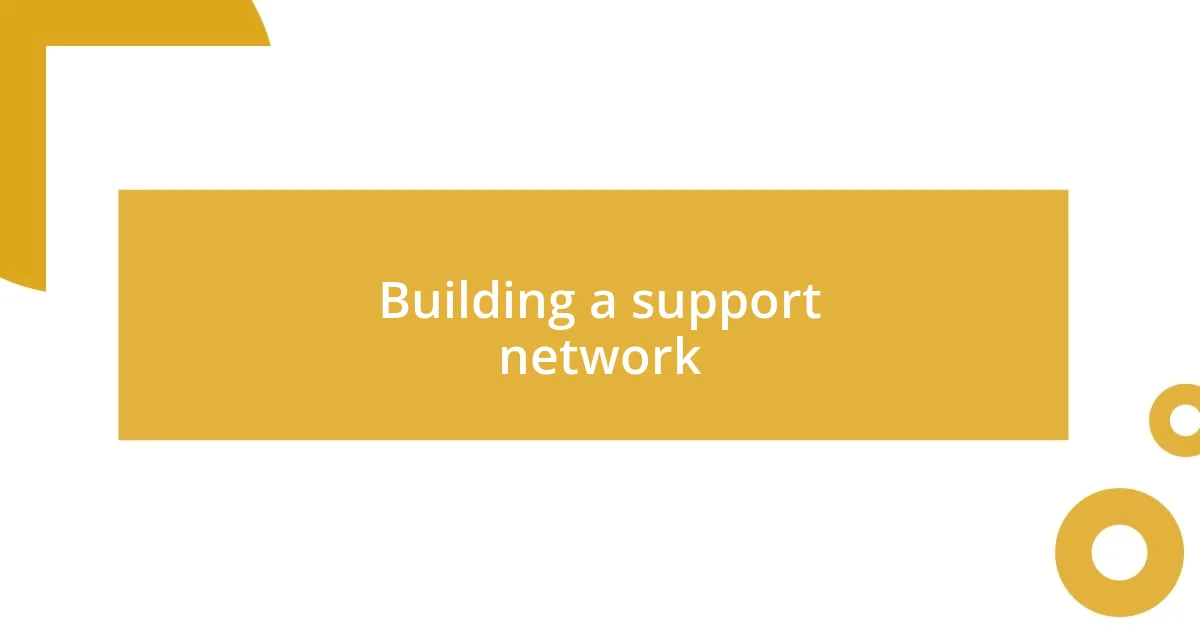Key takeaways:
- Understanding personal support needs involves recognizing emotional and practical requirements that can shift throughout life.
- Identifying and exploring various types of support — emotional, practical, professional, and peer — can enhance personal resilience and connection.
- Effective communication and nurturing relationships within a support network are essential for long-term success and adaptability to changing needs.

Understanding personal support needs
Understanding personal support needs is a journey unique to each individual. I remember a time when I felt overwhelmed and unsure about what kind of support would truly help me. Reflecting on that experience, I realized that recognizing my emotional needs was just as crucial as addressing the practical aspects. Have you ever felt like you were grasping for support but didn’t know exactly what you needed? I certainly have.
I’ve found that personal support needs can shift throughout our lives, often influenced by the challenges we face. For instance, during a stressful work period, I craved understanding and encouragement from friends. On another occasion, when dealing with illness, I found comfort in tangible help, like someone running errands for me. Understanding that we may need different forms of support at different times is a vital aspect of this journey. What kinds of support resonate with you during various life stages?
Identifying your personal support needs requires introspection and sometimes trial and error. There were times I thought I needed space, only to discover I actually thrived with a little companionship. It’s an evolving discovery and can feel daunting. Have you tried exploring different avenues of support? I encourage you to consider them; you might be surprised by what truly uplifts you.

Identifying types of support available
Identifying the types of support available to us can feel overwhelming, yet it’s essential for cultivating personal resilience. Reflecting on my journey, I’ve come to appreciate a variety of support systems that often work in tandem. Just a few years back, I realized that leaning on different forms of support helped me navigate through a challenging time. Some days, a simple text message from a friend offered the boost I needed; other days, I found solace in professional guidance through therapy. It’s fascinating how diverse our support systems can be when we truly start to explore them.
Here are some common types of support you might consider:
- Emotional Support: This includes friends, family, or support groups who provide encouragement and empathy during tough times.
- Practical Support: Tasks like grocery shopping or helping with children, which can alleviate day-to-day stress.
- Professional Support: Therapists or counselors who offer specialized guidance and coping strategies.
- Informational Support: Resources like books, articles, or workshops that provide knowledge and strategies for self-improvement.
- Peer Support: Connecting with individuals who share similar experiences, often found in community or online groups.
I distinctly remember how a neighborhood book club turned into a fantastic informal support group for me. Not only did we share insights on our reading, but we also opened up about life’s ups and downs. This experience reinforced that support can come from the most unexpected places and can be just as important as any formal arrangement.

Exploring emotional support options
Exploring emotional support options can unlock new avenues for healing and connection. I once found myself feeling isolated during a particularly challenging time. A close friend reached out with the simple offer of just being there. This informal check-in turned out to be a pivotal moment for me; sometimes, knowing someone cares is the emotional lifeline we didn’t realize we needed.
There are different options for emotional support, each with its unique flavor. For example, I’ve greatly benefited from support groups, where sharing experiences can create a sense of camaraderie. During those gatherings, I felt a weight lifted, like I wasn’t alone in my struggles. What I find so powerful is how these sessions often invite laughter amidst tears, offering a perfect blend of empathy and understanding. It’s amazing how just being in the presence of others can energize your spirit.
As you explore these options, consider what resonates most with you. For me, moments of vulnerability are essential; I’ve found that engaging in heart-to-heart conversations with friends often leads to deeper connections. Just last month, I had a heartfelt chat with an old friend over coffee, where we both shared our triumphs and challenges, and it truly revitalized my perspective. Have you ever considered how open, honest dialogue could transform your support network?
| Type of Support | Description |
|---|---|
| Emotional Support | Understanding from friends, family, or groups that boost morale and offer empathy. |
| Support Groups | Gatherings of individuals with shared experiences fostering connection and understanding. |
| Therapy | Professional guidance that offers strategies for coping and emotional wellness. |
| Informal Check-Ins | Casual conversations with friends that provide reassurance and perspective. |

Evaluating practical support solutions
Evaluating practical support solutions involves assessing what tangible assistance can best alleviate stress and enhance daily living. I remember a time when balancing work and home responsibilities felt like an overwhelming juggling act. A neighbor offered to pick up my groceries once a week, and that small gesture transformed my schedule. It made me realize how practical help can be a game changer, allowing me to focus on what truly mattered.
When examining the types of practical support available, it’s crucial to consider what aligns with your specific needs. I have often found that getting support doesn’t always mean asking for help outright; sometimes, it’s about recognizing the moments when you could use an extra hand. Whether it’s arranging for someone to watch your children for an afternoon or coordinating a meal train with friends, these actions can profoundly ease the burden of everyday tasks. Have you thought about what practical support could look like in your life?
In my experience, effective support solutions are not universally applicable but instead should be tailored to individual circumstances. For instance, I once organized a home maintenance day where friends helped with yard work. Not only did we tackle the task at hand, but we shared laughs, stories, and a great sense of togetherness. This kind of support reminds me that while the goal is to lighten the load, the shared experience can also strengthen bonds, proving that practicality can indeed blend beautifully with emotional connection.

Building a support network
Building a support network is about finding the people who can be your pillars during tough times. I vividly remember calling an old college buddy after feeling overwhelmed at work. Just that one conversation, filled with laughter and memories, effortlessly reignited my spirit. It’s incredible how a familiar voice can instantly remind you that you’re not navigating this journey alone.
As I’ve developed my support network, I’ve come to value the diverse roles different individuals play. For example, I lean on my sister for honest advice and my neighbor for a listening ear. Their perspectives, although distinct, have been invaluable during challenging moments. Have you considered who in your life fills various support roles? Recognizing these connections can lead to a deeper understanding of your network’s strength.
What truly surprised me was how easily my support network grew when I began sharing my experiences openly. I started attending local meetups with like-minded people, where our shared stories fostered instant connections. One evening, while discussing our struggles and successes over snacks, I felt as if a floodgate of support had opened. These interactions reminded me that sometimes, vulnerability is the key to unlocking new friendships and reinforcing existing ones. How can your openness invite others into your support circle?

Communicating your support requirements
Communicating your support requirements is about being honest and clear about what you need from others. I recall a time when I was juggling multiple projects and felt completely overwhelmed. I took a leap and reached out to my mentor, sharing that I needed guidance and some time to brainstorm ideas. That simple conversation opened up a dialogue, and I received not just the practical help I requested but also a much-needed motivation boost.
It’s essential to articulate your needs in a way that others can understand and respond to. I’ve learned that being specific can make a huge difference. For instance, instead of saying, “I need help with my workload,” I specified, “Can you help me outline the key tasks I need to focus on this week?” This clarity not only made it easier for my colleagues to assist me but also allowed me to feel more empowered in asking for precisely what would benefit me most. How often do you think about how specific you can be when seeking support?
Sometimes, I find it helpful to express my emotions alongside my request for support. One day, I told a friend, “I’m feeling really uninspired and anxious about the project deadline.” Sharing this vulnerability led to a heartfelt discussion about experiences we both faced, which ultimately created an environment where my friend not only offered help but also understood my emotional state. This made our collaboration much more effective. How does sharing your feelings influence the support you receive?

Maintaining support for long-term success
Maintaining support for long-term success goes beyond just assembling a group of supportive individuals; it requires nurturing these relationships. I remember an instance where I made it a point to check in regularly with a friend, even on the days when I felt overwhelmed myself. This ongoing connection wasn’t just about support during tough times; it fostered a deeper bond that made asking for help much easier when life got hectic. Have you thought about the small gestures that can strengthen your support relationships over time?
Another key aspect is being adaptable to the changing needs of both yourself and your support network. I’ve found that, as my goals evolve, the type of support I need shifts as well. A few months ago, I realized I needed more accountability in my fitness journey, so I reached out to a workout buddy I hadn’t leaned on before. It was a simple ask, but being open to evolving dynamics ensured I received the encouragement I sought. Isn’t it fascinating how our support needs can be so fluid?
Lastly, celebrating the successes within your support network can significantly enhance its longevity. I recall organizing a small get-together after I completed a challenging project at work, inviting those who had encouraged me along the way. Sharing that win not only strengthened our connections but also created a sense of shared accomplishment. Why not consider how acknowledging achievements, both big and small, can reinforce the importance of your support system?














